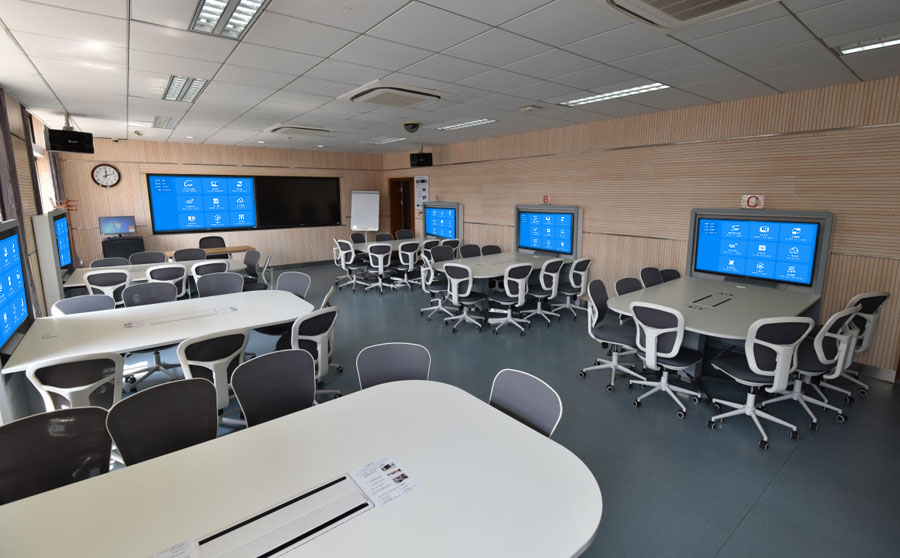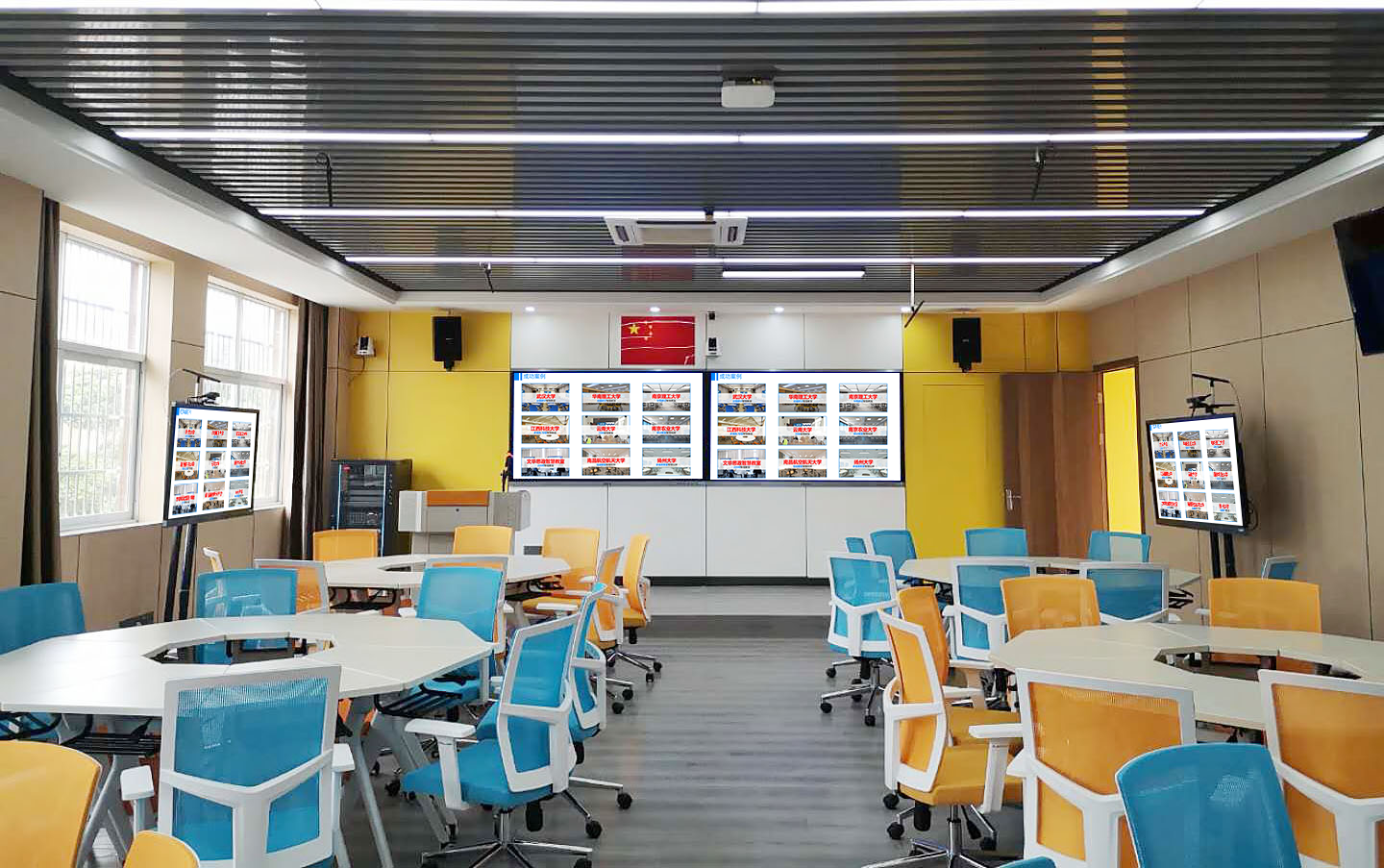Group Discussion: More Efficient Collaboration and Sharing
Want to solve the problem of “difficulty in synchronizing group results and low efficiency in cross-group communication” during group discussions? This screen mirroring device makes it easy! It supports independent screen mirroring for multiple groups, one-tap sharing of results, and real-time cross-group interaction, covering scenarios such as corporate proposal discussions, training breakouts, and academic exchanges. It transforms discussions from “dispersed communication” to “collaborative efficiency,” and even new users can quickly get started.
1-Minute to Set Up a Discussion Scenario, Zero Technical Threshold
Simple operation to quickly activate group collaboration mode:
- Multi-Screen Networking Ready: Screen mirroring receivers are connected to each group’s secondary screen and the main display screen respectively. After powering on, group identifiers are automatically assigned (e.g., “Group 1 Discussion Screen,” “Group 2 Discussion Screen,” “Main Display Screen”). Participants’ computers and tablets connect to the discussion area Wi-Fi, with no drivers or software installation required.
- Independent Group Mirroring: Each group clicks “Project” on their computer to select the corresponding group’s secondary screen, or uses the phone’s control center to connect via “Screen Mirroring.” Independent mirroring is completed in 1-2 seconds, allowing real-time display of ideas and annotation of proposals within the group, without interfering with others. The main display screen temporarily stores the aggregated content for the entire discussion, to be presented uniformly after the groups complete their discussions.
Core Advantages: Adapting to Group Discussion Needs
Multiple Groups Independent Mirroring, Collaboration Without Interference
- Supports 3-8 groups simultaneously mirroring independently. Each group’s secondary screen only displays its own content (e.g., Group 1 analyzing market data, Group 2 designing a promotion plan). Group members can focus on discussion and real-time modifications (computer casts framework, tablet adds details, phone captures handwritten ideas), avoiding interruptions from other groups’ content, boosting focus by 50%.
- Multiple devices within a group can take turns mirroring: Member A uses a computer to cast the preliminary proposal framework, Member B uses a tablet to supplement user profiles, and Member C uses a phone to capture competitor case studies. Content transitions seamlessly without repeatedly plugging and unplugging devices, making collaboration more continuous. Preliminary group discussions can be completed in 15 minutes.
One-Tap Sharing of Results, Smoother Cross-Group Communication
- After a group completes its discussion, clicking “Push to Main Screen” on the mirroring device synchronizes the results to the main display screen in 1 second for everyone to view. No need for group representatives to “take turns plugging in and presenting on stage,” saving 30% of results sharing time. For example, 5 groups’ discussion results can be synchronized in just 2 minutes, avoiding the inefficiency of “waiting for presentations” in traditional discussions.
- Supports “multi-group results split-screen comparison“: The main display screen can simultaneously show 2-4 core proposals (e.g., Group 1 on the left, Group 2 on the right, Group 3 at the top, Group 4 at the bottom). Differences (e.g., budget allocation, execution period) are clear at a glance, eliminating repeated content switching during cross-group communication, making idea collision more direct, and quickly integrating advantageous ideas.
Real-time Interactive Annotation, More In-Depth Discussion
- After group results are mirrored, the moderator can use a tablet to annotate modification suggestions on the main screen (e.g., “Need to supplement user research data here,” “Execution steps can be optimized”). Annotation traces are synchronized back to the corresponding group’s secondary screen. Groups can adjust their proposals in real-time, eliminating “secondary modification after taking notes,” boosting feedback efficiency by 60%.
- When asking cross-group questions, the questioner can use a phone to photograph their group’s supplementary ideas (e.g., “Our group’s cost control method can be referenced”) and push it to the main screen with one tap. The corresponding group can respond in real-time on their secondary screen (annotating “This method is suitable for X scenario” with a computer). Interaction avoids “shouting out loud,” making the discussion atmosphere more focused and preventing irrelevant interference.

Applicable to All Scenarios: Empowering Group Discussions
Corporate Proposal Discussions: More Precise Decision-Making
- The marketing department discusses new product promotion plans in groups. Group 1’s secondary screen shows channel planning (online and offline ratios), Group 2’s secondary screen shows budget allocation (cost proportion for each channel), and Group 3’s secondary screen shows risk response strategies. After the discussion, they push to the main screen for split-screen comparison. The moderator annotates “Channel overlaps need optimization” and “Budget can be tilted towards high-conversion channels.” Quickly integrate advantages across groups, boosting proposal refinement efficiency by 50%.
- Product development groups discuss functional design. Each group casts prototype diagrams to their secondary screen. Group members use styluses to annotate interaction logic (e.g., “Button position needs adjustment,” “Process can be simplified”). After results are pushed to the main screen, the technical group directly annotates technical feasibility on the main screen (e.g., “This interaction needs to be compatible with older system versions”), reducing communication deviations due to “discrepancies between plan and technology.”
Training Breakouts: More Active Learning
- Sales training groups simulate customer communication scenarios. Each group casts communication scripts and response strategies (e.g., script templates for handling customer haggling) to their secondary screen, with members taking turns demonstrating. After results are pushed to the main screen, the trainer annotates “Scripts can add case support” and “Response pace needs to slow down.” Other groups can supplement their experiences in real-time (e.g., “Our group’s customer segmentation communication method is more suitable”). Interactive learning boosts efficiency by 40% compared to traditional training.
- Management training groups discuss case solutions. Each group casts their analysis ideas (problem decomposition, responsibility division, execution steps) to their secondary screen. After completion, the main screen performs a split-screen comparison. Trainees provide cross-group feedback (e.g., “Group 1’s problem decomposition is more comprehensive,” “Group 3’s execution steps are more specific”). The trainer summarizes general methods (e.g., “Problem decomposition needs to be combined with data support”), leading to a more thorough absorption of knowledge.
Academic Exchanges: Fuller Clash of Ideas
- Research teams discuss experimental protocols in groups. Group 1’s secondary screen shows data collection ideas (sample selection, detection methods), and Group 2’s secondary screen shows analysis methods (model construction, error control). During independent mirroring, group members focus on verifying details (e.g., “Is the sample size sufficient?” “Does the detection instrument precision meet standards?”). After results are pushed to the main screen, experts use computers to supplement literature references (e.g., “This method needs to combine the sample calibration method of XX research”). Cross-group academic exchange is more professional, quickly refining experimental protocols.
- Student groups discuss research topics. Each group casts their research report (scope, data conclusions, recommendations) to their secondary screen. After completion, they push to the main screen. The teacher provides real-time annotations such as “Research scope can be expanded to second-tier cities” and “Recommendations need to be supported by data.” Groups modify simultaneously on their secondary screens. Discussion and optimization proceed in sync, eliminating post-meeting readjustments and accelerating project progress by 30%.
Practical Details: Peace of Mind for Discussion Scenarios
- Stable Transmission and Anti-interference: Dual-band (2.4GHz+5.8GHz) transmission technology ensures that when multiple groups mirror simultaneously, latency is ≤20ms. Page-flipping and annotation are smooth without lagging. Large discussion meetings (50+ people) won’t “fall apart,” avoiding “mirroring interruptions affecting ideas.”
- Permission Control Prevents Interference: Set “group mirroring permissions.” Only authorized personnel within the group can modify mirrored content (e.g., delete incorrect annotations, add new content). Main display screen permissions are controlled by the moderator, preventing irrelevant operations (e.g., accidental deletion of results, pushing irrelevant content) from interrupting the discussion.
- Portable and Easy to Deploy: The screen mirroring device is palm-sized, weighing less than 40g. When temporarily adjusting the number of groups (e.g., from 3 to 5 groups), receivers can be quickly added or removed, adapting to discussion needs of various scales from 5-50 people. No complex pre-cabling is needed, flexibly adapting to various discussion scenarios.
Whether for corporate proposal discussions, training breakouts, or academic exchanges, using this screen mirroring device to set up group discussion scenarios can make group collaboration more focused, results sharing more efficient, and cross-group interaction more in-depth, truly enhancing the value and efficiency of discussions and helping to rapidly produce high-quality results.